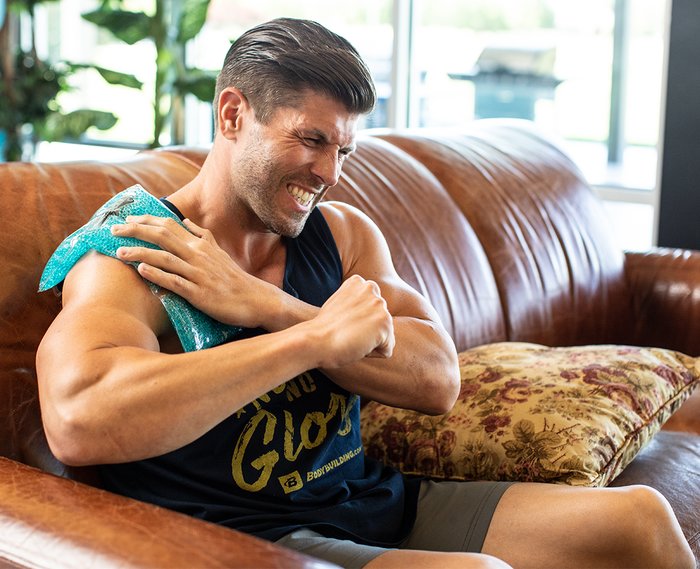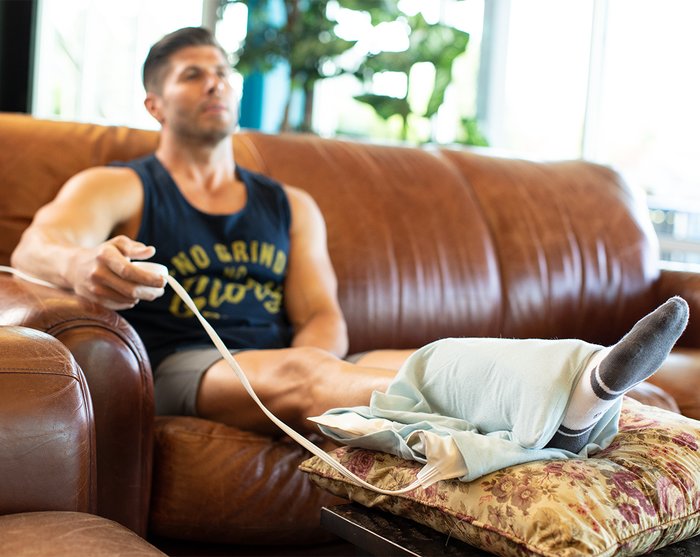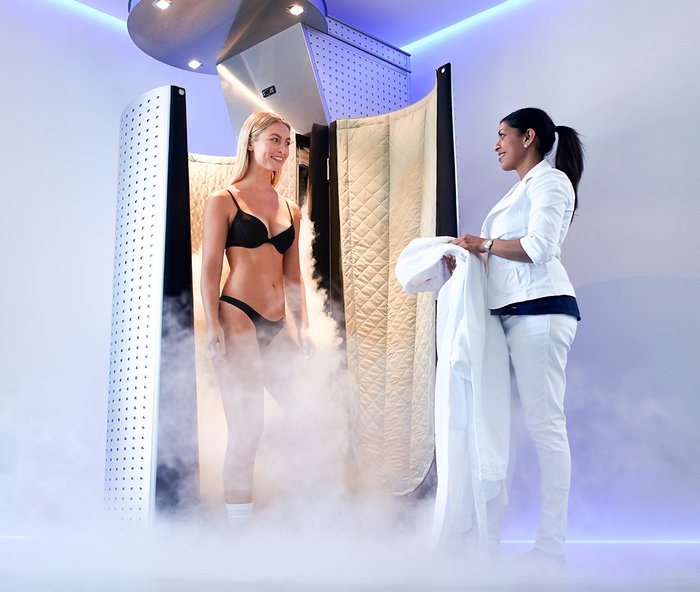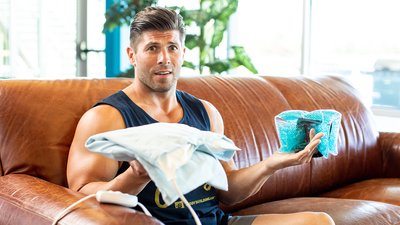If you're like most gym rats, you're probably looking for an edge, that "thing" that will turn you from a mere mortal into a gym-crushing, injury-proof, never-had-a-sore-muscle machine. If you think a couple of ice packs or a heating pad could help you transcend the aches and pains that cause the rest of us to skip a workout, you might want to think again.
Both hot and cold therapies offer modest pain-reduction effects, but research doesn't fully support either one as an "answer" to healing, pain relief, or recovery. Despite all the research on this topic, therapists and doctors continue to make wide-ranging suggestions regarding when, and if, to use either method.
What's Your Goal: Injury Treatment, Pain Relief, or Fast Recovery?
Recently, while walking through the hallways at the University of Mary Hardin-Baylor in Belton, Texas, I stopped a colleague, Paul LaBounty, Ph.D., a physical therapist and associate professor of exercise and sport science, to ask his advice on whether to use hot or cold therapy to treat an injury.
"If you ask a few therapists that question, you'll get a few different answers," said LaBounty. Generally speaking, he said, use ice to treat acute injuries, and then later use heat to prevent stiffness. If someone twists an ankle playing basketball, the standard advice, he says, is to apply ice to limit or reduce swelling, and then follow up a few days later with heat to encourage recovery.
This approach has been reasonably well-supported by research. LaBounty notes, however, that "current research indicates applying ice may not offer the benefits we thought it did. The evidence just isn't that clear."
Making the decision to use hot or cold treatment is complicated by the specific goals of the treatment and by the fact that results of either modality are mixed. Clearly, more research needs to be done, but the research that has been done supports the following use cases.
Heat or Cold?
Use Ice for Immediate Relief
There's much to be said for the psychological benefits of just doing something when it comes to post-injury pain reduction. Popping an over-the-counter pain med is a good place to start, but applying cold to the site of the injury can also offer some immediate relief.
Your skin has nerve receptors called "thermoreceptors" that are activated when you experience changes in skin temperature, such as when you apply heat or cold to an injury site. Thermoreceptor activation can reduce the experience of pain by blocking pain signals that travel from the spinal cord to the injury site.[1]
Cold therapy (cryotherapy) is used immediately following an injury because it constricts blood vessels (vasoconstriction) to reduce blood flow to the area, which limits the inflammation and muscle spasms that also cause pain. You can use ice packs, cold whirlpools, cooling sprays, or ice massage, although some evidence indicates that cold-water immersion provides the greatest benefit.[2]

It is unclear, though, whether cold results in more than short-term pain reduction. A 2015 review study published in the Journal of Postgraduate Medicine reported limited evidence to support the use of cold therapy following acute musculoskeletal injury and delayed-onset muscle soreness (DOMS).[3]
Another review study published in The Annals of Sport Medicine and Research looked specifically at the outcomes of cold therapy following acute lateral ankle sprains.[4] One study presented in this review divided participants into two groups: a control group, which received no other intervention beyond rest and ibuprofen; and a second group, which received these same interventions plus cryotherapy.[5] At the end of the study, researchers found no significant differences in recovery time between the two groups, suggesting that cold therapy doesn't speed injury recovery time—at least not for lateral ankle sprains.[5]
Because it reduces blood flow, cold therapy may actually slow recovery time. Less blood flow can lead to increased muscle stiffness—not a great outcome if you're an athlete.[6]
Use Heat to Increase Blood Flow
Like ice therapy, heat therapy also activates the skin's thermoreceptors to help block pain signals, but it does it in almost the exact opposite way. Where cold therapy results in vasoconstriction, heat therapy causes vasodilation, which increases blood flow to the site of the injury. More blood flow means that more protein, nutrients, and oxygen are delivered to the injury site, and more metabolic byproducts of tissue damage are washed away. Both actions ultimately aid the healing process.[6]
Heat also loosens muscles to enable greater movement, which is critical for regaining range of motion and speeding your return to the gym. This makes heat therapy a good option when you're experiencing muscle stiffness or pain. A 2017 study published in the Journal of Hand Therapy found that 15 minutes of heat therapy using either a moist hot pack or a hot whirlpool bath improved range of motion of an injured wrist prior to engaging in other therapeutic treatments.[7]

Heat can also be a good pre-workout treatment when you're easing your way back into exercise after an injury. In fact, if you find yourself sidelined from the gym for longer than you'd like, it might be a good time to hit the sauna. Findings from two 2017 studies found that 30-minute sauna baths produced similar benefits for your cardiovascular system as moderate-intensity exercise.[8,9]
That's not to say you should permanently replace your cardio sessions with daily trips to the sauna, but as long as you're past the extreme swelling stage of your injury, the addition of heat is unlikely to cause any problems—and could deliver some significant benefits.
Whole-Body Cryotherapy? It's Your Call
If you follow podcasts like The Tim Ferriss Show or track the training habits of high-level athletes like LeBron James, you may have heard them tout the benefits of whole-body cryotherapy. This treatment is typically done in a cryotherapy chamber, in which the athlete is subjected for 2-3 minutes to temperatures as low as -300 degrees F. Proponents claim the therapy offers everything from faster post-workout recovery to improved athletic performance.
The science is not quite as definitive. A 2017 review of literature published in Frontiers in Physiology acknowledges that there do seem to be positive effects from intense cryotherapy, including reduced inflammation and subjective feelings of improved recovery post-exercise. However, the studies cited in the review were small in size and used varied research parameters. Other studies in the same literature review indicated no effect whatsoever from the treatment.[10] Given that whole-body cryotherapy chambers are not commonly available—and quite expensive—this form of cold treatment may not be a realistic solution for most people.

If you find yourself far from a cryogenic chamber or short on cash, try this: Fill up your bathtub with ice and water and ease yourself down into it. A 2012 study published in the Sao Paulo Medical Journal found that post-workout ice baths, commonly used by many professional sports teams, do appear to reduce the effects of DOMS. It was not clear, though, whether the benefits were better than other intervention protocols, such as foam rolling.[11]
Hot and Cold Together?
Finally, there is the idea of mixing together hot and cold treatments. Contrast water therapy (CWT) has been used among elite-level athletes to help them recover quickly from the daily wear and tear of their professions. In this technique, the affected body part is immersed alternately in cold and hot water. The theory is that the contrasting temperatures creates a pumping action as the blood vessels move back and forth between the vasoconstriction caused by cold and the vasodilation caused by heat. The pumping action is reported to reduce muscle spasm and inflammation and increase range of motion.[12]
The Finns made primitive saunas more than 2,000 years ago. The Russians love to take ice baths. We humans seems to know instinctively that there is something good to be had by exposing ourselves to these extreme elements. We may still not know what exactly is the best combination of the two—or whether there will ever be definitive scientific support for either one—but we just can't seem to stop trying.
References
- Nadler, S. F., Weingand, K., & Kruse, R. J. (2004). The physiologic basis and clinical applications of cryotherapy and thermotherapy for the pain practitioner. Pain Physician, 7(3), 395-400.
- Herrera, E., Sandoval, M. C., Camargo, D. M., & Salvini, T. F. (2010). Motor and sensory nerve conduction are affected differently by ice pack, ice massage, and cold water immersion. Physical Therapy, 90(4), 581-591.
- Malanga, G. A., Yan, N., & Stark, J. (2015). Mechanisms and efficacy of heat and cold therapies for musculoskeletal injury. Postgraduate Medicine, 127(1), 57-65.
- Yerhot, P., Stensrud, T., Wienkers, B., & Durall, C. (2015). The efficacy of cryotherapy for improving functional outcomes following lateral ankle sprain. Ann Sports Med Res, 2, 1015.
- Sloan, J. P., Hain, R., & Pownall, R. (1989). Clinical benefits of early cold therapy in accident and emergency following ankle sprain. Emergency Medicine Journal, 6(1), 1-6.
- Point, M., Guilhem, G., Hug, F., Nordez, A., Frey, A., & Lacourpaille, L. (2018). Cryotherapy induces an increase in muscle stiffness. Scandinavian Journal of Medicine & Science in Sports, 28(1), 260-266.
- Szekeres, M., MacDermid, J. C., Grewal, R., & Birmingham, T. (2017). The short-term effects of hot packs vs therapeutic whirlpool on active wrist range of motion for patients with distal radius fracture: A randomized controlled trial. Journal of Hand Therapy.
- Laukkanen, T., Kunutsor, S. K., Zaccardi, F., Lee, E., Willeit, P., Khan, H., & Laukkanen, J. A. (2018). Acute effects of sauna bathing on cardiovascular function. Journal of Human Hypertension, 32(2), 129.
- Lee, E., Laukkanen, T., Kunutsor, S. K., Khan, H., Willeit, P., Zaccardi, F., & Laukkanen, J. A. (2018). Sauna exposure leads to improved arterial compliance: Findings from a non-randomised experimental study. European Journal of Preventive Cardiology, 25(2), 130-138.
- Lombardi, G., Ziemann, E., & Banfi, G. (2017). Whole-Body Cryotherapy in Athletes: From Therapy to Stimulation. An Updated Review of the Literature. Frontiers in Physiology, 8, 258.
- Bleakley, C., McDonough, S., Gardner, E., Baxter, D. G., Hopkins, T. J., Davison, G. W., & Costa, M. T. (2012). Cold-water immersion (cryotherapy) for preventing and treating muscle soreness after exercise. Sao Paulo Medical Journal, 130(5), 348-348.
- Bieuzen, F., Bleakley, C. M., & Costello, J. T. (2013). Contrast water therapy and exercise induced muscle damage: a systematic review and meta-analysis. PLoS One, 8(4), e62356.

